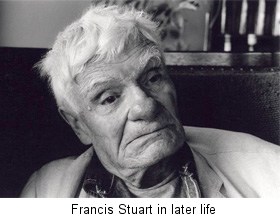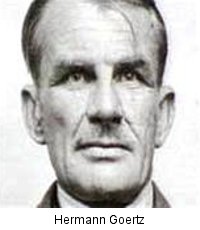Journal Volume 4 2004
Major Hermann Goertz and German World War 2 Intelligence Gathering in Ireland (continued/3)
Preparation for Irish Mission
 Goertz suggested to the Abwehr that members of the IRA. should be used in Britain as saboteurs and to create revolt in Northern Ireland but this idea did not go down well with the German High Command. Goertz persisted with this view and managed to persuade the Abwehr to allow him 3 months to prepare for a mission to Ireland. As part of his mission preparations, Goertz contacted a number of Irish people working in Germany including Francis Stuart, who had arrived in Germany in January 1940 to take up a post of lecture in the English Department of Berlin University. Francis Fromme introduced Goertz to Stuart who offered him the opportunity to shelter with his wife in Laragh, Co. Wicklow, should the need arise. What Stuart was doing in Germany at this time is covered in detail in David O’Donoghue's book mentioned earlier and is outside the scope of this paper. Goertz received the standard mission training of using a parachute, operating a wireless transmitter, the use of secret communications, and the coding/decoding of messages. During his training period, he had the secretarial services of an Irish woman, Nora O’Mara, who was working in Germany and later was a mistress of Stuart.
Goertz suggested to the Abwehr that members of the IRA. should be used in Britain as saboteurs and to create revolt in Northern Ireland but this idea did not go down well with the German High Command. Goertz persisted with this view and managed to persuade the Abwehr to allow him 3 months to prepare for a mission to Ireland. As part of his mission preparations, Goertz contacted a number of Irish people working in Germany including Francis Stuart, who had arrived in Germany in January 1940 to take up a post of lecture in the English Department of Berlin University. Francis Fromme introduced Goertz to Stuart who offered him the opportunity to shelter with his wife in Laragh, Co. Wicklow, should the need arise. What Stuart was doing in Germany at this time is covered in detail in David O’Donoghue's book mentioned earlier and is outside the scope of this paper. Goertz received the standard mission training of using a parachute, operating a wireless transmitter, the use of secret communications, and the coding/decoding of messages. During his training period, he had the secretarial services of an Irish woman, Nora O’Mara, who was working in Germany and later was a mistress of Stuart.
The German Foreign Office was anxious that Ireland's neutral stance should not be compromised and advised the Army Staff that Goertz should not involve himself in Irish affairs and was to confine his operations to Northern Ireland.
The Goertz mission to Ireland was given the name “Operation Mainau”, with Goertz being assigned the code name of “Gitka”. It was the specific understanding of Goertz that he was being sent to Ireland as an intelligence officer and not as a spy, with the task of liaising with the IRA, making it more interested in Northern Ireland and preparing the way for espionage and sabotage operations there. However the Germans appear to have overlooked the fact that most Republican sympathisers, North and South, were known to both the RUC and the Garda Siochana, and that the more active of these were being kept under surveillance by police and intelligence services on both sides of the Border. Additionally, many Germans nationals in Ireland, some of whom were members of the Nazi Party, had returned to Germany in September 1939 for military service at the request of the German Government, thus depriving the Germans of a network of supporters who could have been utilised to assist and support secret agents like Goertz. Those German nationals remaining in Ireland, like other foreign nationals, were kept under discreet and intermittent surveillance by the Garda for the duration of the Emergency.
Arrival in Ireland
On the night of May 5th 1940, Goertz was parachuted into Ireland from a German aircraft and landed near Ballivor, Co.  Meath, though his intended landing zone was supposed to be in Co. Tyrone, wearing full military uniform so that if captured he could claim prisoner of war status as a German officer and not as a spy. Goertz was extremely sensitive about this point always maintaining that he was an intelligence officer and not a spy. A second parachute containing his radio transmitter and other items went adrift and in the darkness he was unable to locate it. After burying most of his uniform and parachute, he set out for Iseult Stuart's house in Laragh, dressed in breeches, riding boots, pullover and black beret. The other possessions he carried with him included a phial of cyanide, which he intended to take if captured, as well as a considerable quantity of British and American currency notes.
Meath, though his intended landing zone was supposed to be in Co. Tyrone, wearing full military uniform so that if captured he could claim prisoner of war status as a German officer and not as a spy. Goertz was extremely sensitive about this point always maintaining that he was an intelligence officer and not a spy. A second parachute containing his radio transmitter and other items went adrift and in the darkness he was unable to locate it. After burying most of his uniform and parachute, he set out for Iseult Stuart's house in Laragh, dressed in breeches, riding boots, pullover and black beret. The other possessions he carried with him included a phial of cyanide, which he intended to take if captured, as well as a considerable quantity of British and American currency notes.
His orders were to make contact with James O'Donovan in Shankill but first he had to reach Iseult Stuart's house in Laragh, trekking across country undetected, a task that took him 4 days. When he arrived at her house in Laragh on May 9th 1940, she was very unsure of what to make of the dishevelled individual standing in front of her and it was some time before she allowed him in. She sent him to bed and while he slept she went to Dublin and purchased a suit of clothes for him in Switzers of Grafton Street, an action that did not go unremembered by the staff. Later that night, a car driven by James O'Donovan arrived in Laragh to bring him to the house of one of O'Donovan's friends who was supposed to shelter him. This friend then refused to accommodate him so O'Donovan brought him to his own house in Shankill, Florenceville now called Millfield, where he was placed in a vacant room. His son Donal, who normally used this room, was in hospital at that time receiving treatment for a complaint.
Goertz remained out of sight during his stay in Shankill, hidden in the garage at night while by day he was concealed behind a eucalyptus tree with his radio codebook hidden in the eves of the house. During this stay in Shankill, Goertz met Stephen Hayes, new Chief of Staff of the IRA. and held a number of meetings with him. Goertz was armed with two weapons, a pistol and a knife for personal protection, both of which he gave to James O’Donovan for safekeeping until his departure.
Goertz remained in Shankill for about 8 days after which he was moved to a house called Konstanzin Templeogue Road, Dublin, owned by Stephen Held. While there, he provided the IRA with details of the location where he buried his uniform and parachute so that these could be recovered. While his uniform and radio transmitter could not be found, the parachute was successfully recovered and brought to the house where it was burned on the maid's day off.


